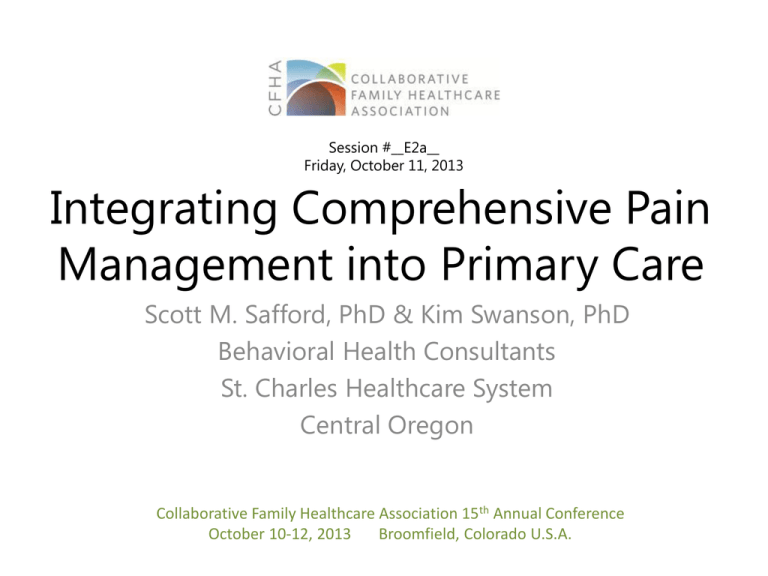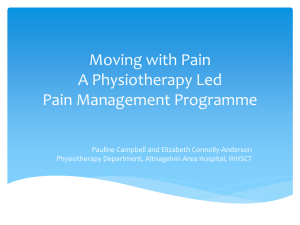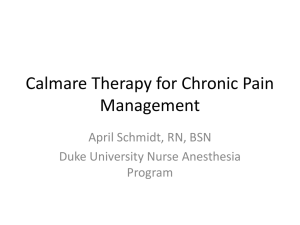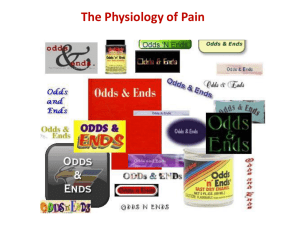
Session #__E2a__
Friday, October 11, 2013
Integrating Comprehensive Pain
Management into Primary Care
Scott M. Safford, PhD & Kim Swanson, PhD
Behavioral Health Consultants
St. Charles Healthcare System
Central Oregon
Collaborative Family Healthcare Association 15th Annual Conference
October 10-12, 2013
Broomfield, Colorado U.S.A.
Faculty Disclosure
We have not had any relevant financial relationships
during the past 12 months.
Objectives
• Describe an integrative intervention model for
managing chronic pain in a primary care
setting
• Identify primary care patients who may
benefit from an integrated chronic pain
intervention
• Discuss strategies for collaborating with
insurance payers to cover the implementation
of an integrated pain management program in
primary care
Learning Assessment
We would be happy to respond to any
audience questions at the end of our
presentation
Why is Integrated Treatment of Chronic
Pain in Primary Care Important?
Why is Integrated Treatment of Chronic
Pain in Primary Care Important?
Chronic pain is a common problem
Estimated 100 million individuals with chronic pain
nation-wide (American Academy of Pain Medicine)
Nearly twice the number of diabetic, cancer, and
cardiovascular disease patients combined (54 million)
Low back pain is the leading cause of disability for
Americans under the age of 45
Why is Integrated Treatment of Chronic Pain
in Primary Care Important?
Patients often have limited access to chronic pain
tertiary care clinics and pain specialists
However, primary care physicians often have concerns
about treating chronic pain due to:
Increased burden of care (time consuming, high
comorbidity)
Concerns about addiction/diversion
Unclear pathological etiology (rely on self-report)
Inadequate knowledge regarding effective prescribing of
opioid medications
Stepped Care and Chronic Pain
Stepped Care and Chronic Pain
Originated in the Veteran’s Health Administration
The Goals of Integrating Comprehensive
Chronic Pain Treatment into Primary Care
Increase patient access to skilled interdisciplinary
treatment
Improve cost-effectiveness of treatment
Improve physician sense of competency and
satisfaction
Primary Care Comprehensive Chronic Pain
Management Program: What it Looks Like
Detection and Prevention (PCP)
Controlled substance agreement contract
Random urine drug screens
Oregon Drug Monitoring Program (ODMP)
Community-wide controlled substance prescription
policy standards
120 mg morphine equivalent dose daily cap
Avoiding polypharmacy
Primary Care Comprehensive Chronic Pain
Management Program: What it Looks Like
Risk Stratification and Systematic Screening for
Comorbid Conditions (BHC)
PHQ, GAD-7, Pain Disability Index, Opioid Risk Tool
Pain School for Chronic Pain Management (BHC)
Coordination of care referrals to secondary and tertiary
care (BHC or PCP)
What is Pain School?
4-session psychosocial intervention:
Each class includes providing information about chronic pain, working on
applied skills to help manage chronic pain, and teaching various relaxation
techniques
Topic areas include:
Acute versus chronic pain
Current theories of chronic pain
Pain diary and pain scale
Pacing
Exercise and stretching
Balancing productive activities, enjoyable activities, and rest
Problem-solving/Goal-setting
Maladaptive thinking patterns and coping strategies for addressing them
Interpersonal relationships, pain behaviors and communication styles
Sleep hygiene / behavioral strategies for managing sleep
Relaxation strategies (diaphragmatic breathing, PMR, guided imagery)
Involving the Payers
Behavioral health interventions covered by Health and
Behavior Individual and Group CPT billing codes
Coverage negotiated by hospital with insurance carriers
Central Oregon Medicaid Provider: PacificSource
Community Solutions
Negotiating coverage of the cost of treatment
Obtaining claims data
Providing referrals (future direction)
Evaluating Outcomes
Outcomes Measures
Measures
Pain Severity: Numeric Rating Scale
Functioning: Pain Disability Index
Psychological: PHQ-9, GAD-7
Risk Stratification: ORT
Physician Compliance
Documentation
Urine toxicology screening
Tracking aberrant drug related behavior
Use of Oregon Prescription Drug Monitoring Program
Adherence to daily morphine dosage equivalent caps
Physician satisfaction
Current Outcomes: Demographics and
Payer Source
Completers 125
Age (Mean) 52
Sex (F/M)
82/43
Insurance
Carrier(N)
BCBS =
Medicaid/OHP =
Medicare =
MODA/ODS =
PacificSource =
PP-PEBB =
Self Pay =
6
54
45
7
3
3
7
Current Outcomes
Pain School PHQ-9 Data
20
5.
85
7.
79
5.
45
8.
08
5.
19
8.
07
5.
58
10
8.
83
15
5
0
1N
=121
2N= 3 N= 4 N=
124
121
125
Time
Mean
St Dev
Current Outcomes
Anecdotal Physician Satisfaction
“It is nice to have a
‘program/standard of care”
“I feel less anxious about
treating pain patients because I
feel more supported”
Physician Adherence (N = 14)
Controlled substance agreement
= 85%
Urine Toxicology Screening =
85%
Oregon Prescription Drug
Monitoring Program = 85%
Evaluation for Risk Stratification
and Comorbidities = 64%
Documentation to Best
Practices = 0%
Medicaid Claims Data
Claims Data
OHP/Medicaid
Date Range 1/1/20127/30/2012
N = 26
Total Costs
Before First
Appointment
Date
Total Costs
after last
appointment
date
$159,345.45
Savings
$31,236.19
$128,109.26
Cost & Projected Return on Investment
The Case of Ms. Hello
Kitty
ED Diversion Patient
Attended Pain School =
$192.00
I BHC Assessment =
$110.00
6 BHC interventions $576
To Date Savings 2013 =
$27,306
2012
2013
15 ED visits 2 ED visits
Total Cost = Total Cost =
$32,520
$4336
Future Directions
Expanding role of RNCC and addition of CHW in
primary care team
Metrics
Claims data
Health Care Utilization
Pharmacy data
ED use
Specialty Care use
PCP Satisfaction
Physician adherence to treatment model
Questions & Answers
Session Evaluation
Please complete and return the
evaluation form to the classroom monitor
before leaving this session.
Thank you!










